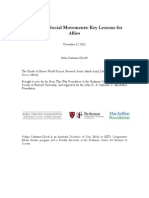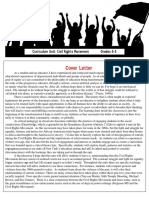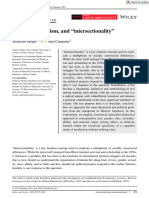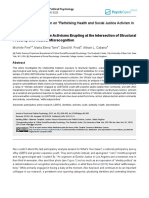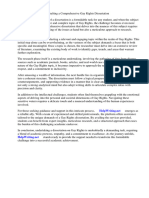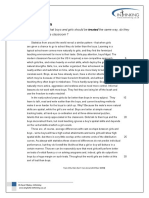Social Justice/Global Options
Social Justice/Global Options
Uploaded by
Nicholas BradyCopyright:
Available Formats
Social Justice/Global Options
Social Justice/Global Options
Uploaded by
Nicholas BradyOriginal Title
Copyright
Available Formats
Share this document
Did you find this document useful?
Is this content inappropriate?
Copyright:
Available Formats
Social Justice/Global Options
Social Justice/Global Options
Uploaded by
Nicholas BradyCopyright:
Available Formats
This Is an Illogical Statement: Dangerous Trends in Anti-Prison Activism Author(s): Camille E.S.A.
Acey Reviewed work(s): Source: Social Justice, Vol. 27, No. 3 (81), Critical Resistance to the Prison-Industrial Complex (Fall 2000), pp. 206-211 Published by: Social Justice/Global Options Stable URL: http://www.jstor.org/stable/29767243 . Accessed: 04/05/2012 13:47
Your use of the JSTOR archive indicates your acceptance of the Terms & Conditions of Use, available at . http://www.jstor.org/page/info/about/policies/terms.jsp JSTOR is a not-for-profit service that helps scholars, researchers, and students discover, use, and build upon a wide range of content in a trusted digital archive. We use information technology and tools to increase productivity and facilitate new forms of scholarship. For more information about JSTOR, please contact support@jstor.org.
Social Justice/Global Options is collaborating with JSTOR to digitize, preserve and extend access to Social Justice.
http://www.jstor.org
This Is an Illogical Statement: Dangerous Trends in Anti-Prison Activism1
Camille E.S.A. Acey
A MOVEMENT CALLED JAILS" HAS DOMINATED MUCH OF
RECENTLY,
"SCHOOLS
NOT
the popular discourse surrounding the alarming rise of incarcerated America. Iwould like todiscuss, in general terms, some of the peoples in that thismovement poses to radical anti-prison work. I am speaking problems my critique can find some currencywith otherswho are generally in thehope that with theproblematic of theembedded liberal ideological apparatus, which dealing holds that thevery violence thatconstitutes social institutions ismerely a curable
excess.
Introduction Institutions are created and maintained by hegemony Hegemony is created and maintained by violence Hegemony is violence Institutions are violence School is an institution Institutions are created and maintained by hegemony Hegemony is created and maintained by violence Hegemony is violence School is violence Time is an institution Institutions are created and maintained by hegemony Hegemony is created and maintained by violence Hegemony is violence Time is violence Jail is an institution Institutions are created and maintained by hegemony
E.S.A. Acey is radical black feminist student, activist, and educator. She is currently a fourth site: http:// Web student at U.C. (e-mail: camil@uclink4.berkeley.edu; Berkeley her lifeplan is to keep on struggling, learning, and thinking. Her www.geocities.com/camillesname/); current academic interests include genocide, afrofuturism, and cyberculture. She wishes to extend her deepest gratitude toDylan Rodriguez and Jared Sexton for all their help. Camille year
206
Social Justice Vol. 27, No. 3 (2000)
Anti-Prison Activism Dangerous Trends in Hegemony is created and maintained by violence Hegemony is violence Jail is violence School uses time Jail uses time Institutions use institutions Institutions are created and maintained by hegemony Hegemony is created and maintained by violence Hegemony is violence Violence uses violence Schools not jails Institutions not institutions This is an illogical statement.
207
In the mid-1990s, "Schools Not Jails" (SNJ) (and othervariations thereof,such as "JobsNot Jails") was circulating inCalifornia as a popular rallying cry for anti prison movements, but more recently ithas grown into its own movement. As a
Meetings were closed and businesslike, and the focus shifted from progressive political education to effective campaign management. This movement did not explicitly tie itself to a history of social justice movements in theUnited States; rather, it seemed for thismovement that time began with Proposition 187 and would go on as long as therewere propositions to oppose.3 Most recently, the "Schools Not Jails" slogan was used in the failed campaign against California's Proposition 21.With stipulations such as the legalization ofwiretapping on those
bridge between emerging youth activism and anti-prison advocacy, this ideology seeks inpart to draw crucial links between the underfunding of schools and the ever-burgeoning prison-industrial complex. It is not at thispolitical location that movement. As one of the students who was politicized in the I seek to critique this was no space for era ofProposition 209,21 soon found thatthere my radical critique when "Schools Not Jails" ballooned into amovement. of government institutions
the level of political education around this issue would have been superb. was not thecase. Taking the lead from the"youth" organizers, a new However, this naivete permeated theorganizing. SNJ grew inpopularity because of its simplicity ? it is clear, catchy, and itfits neatly on a bumper sticker and straightforwardness or a tee shirt.For this reason, SNJ is also dangerous. This and other such slogans indicate a revolt against what science fiction author and literarycritic, Samuel Delany, has referredto as the "problem of 'complex rhetoric.'"4 This revolt, in the name of popularizing a limited leftist agenda, is waged at the expense of the
the police deem "gang members" and increasing penalties for "gang-affiliated" crimes, Proposition 21 set into law the practices that the legal system (in conjunction with theFBI and other federal agencies) has used against activists for with seasoned activists at the head of theorganizing, years. One would think that
208
ACEY
margins. Thus, I wish to speak from themargins and discuss how attempts at "mainstreaming" a leftistpolitical agenda problematize and often censure the project, precluding the development of a radical counter-hegemonic political slogan "education not incarceration" grew out of the link between university student anti-Proposition 209 activism and grass-roots high school student activism.6 In themid- to late 1990s, a number of studentwalkouts and protests were led throughout the state of California. The main emphasis of university studentswas on increasing access to theuniversity forpoor, working class communities of color and promoting more relevant curricula. High school students from those communities voiced concerns over insufficienteducational resources, declining economic opportunity, and the growing criminalization of theirgeneration. Often, many of theorganizations came together todevelop more The
language.5
comprehensive, radical critiques of these issues and strategies for political education. Though it is often believed thatSNJ is a variation on "education not incarceration," I would argue that that it is a corruption. During workshops or would often express theirextremely valid meetings with high school students, they belief thatthepurpose of high school was to "get you ready togo toprison." Under the SNJ regime, this staunchly anti-school critique, from those incarcerated in some of thecountry'smost egregious junior highs and high schools, was censored. Soon college students and graduates were employed (and developed theirown organizations) to effectively handpick and manage youth organizers. They gave media and policed any nihilistswho themcrisp, clean sound bites todeliver to the feel the urge to yell "Fuck school!" during an SNJ rally.However, armed might won't quit, the "Schools Not Jails"movement with inaccuracies and a slogan that ? thewillingness and embodied the oldest form of anti-intellectual nihilism
determination to be intensely ignorant. The liberal ideology behind SNJmay have been more fittingforawelfare state. With continual corporate downsizing andmassive global economic restructuring, a sizable and ballooning population has emerged whose bodies capitalism has discarded, and who (because of their youth, race, gender, imprisonment, and unemployability) often fall outside the scope of even the broadest Marxist analysis. Further, in collaboration with massive policing efforts,corporations and supranational organizations have succeeded inclosing down our streetsand public spaces.While the anti-welfarewarfare state shifts its resources to building global communication, our immediate communities have been ignored; in fact, the term "community" has nearly faded from daily discourse as a signifier for specific geographic locales. Urbanist Paul Virilio (1999: 41) describes thedanger of this new sentiment toward personal social interaction: if tomorrowwe love only our distant neighbor without being conscious of hating our neighbors because they're present, because they smell,
Dangerous
Trends in Anti-Prison Activism
209
because they're noisy, theybotherme and they summonme, unlike my distant neighbor who I can zap.. .so if tomorrowwe startpreferringour distant neighbor at the expense of our neighbor, then we would be
destroying the city....
This idea has helped to change attitudes toward social responsibility and to facilitate a staunchly anti-"handout" mentality. Hope in quick-fix liberal-demo? cratic programs is quickly decaying among thepoor. As anti-prison activists,we must struggle to understand thisperiod as a time of crisis, because only in a time of crisis do we begin to deconstruct our relationship with language and time. Time and Crisis In his appropriately named essay, "TIME," San Quentin inmateEddy Zheng said: "After I was sent to prison to do a life sentence, it forcedme to thinkabout time...." I would even suggest that institutions require that you not only think
Examining the relationship between popular anti-prison rhetoric and the expressed realities of prison life reveals a huge divergence in political locations. Activists often speak about the "state" without specifically defining what they mean by it. Similarly, they think about the "state"? and by extension "state ? in termsof locality (ofteneven pointing to specific buildings). At every power" moment thatpower iswielded, it is established, exercised, and reasserted through the invocation of ideological institutions. These institutionssubsequently help to violently enclose space?whether throughtheact of land grabbing or ghettoization. Therefore, when formulating a radical understanding of, and opposition to, state power, it is necessary for us to locate and deconstruct the iterative space from which power flows, recognizing and continually addressing the fact that space (and, by extension, spatial metaphor) is in constant flux. A metaphor for the liberal-democratic ideal is the idea of a working body? a healthy body with all theorgans functioningproperly. Some popular anti-prison discourse is similar to the complaint of a sick patient: particular institutions are
Iwanted to go. There weren't any set guidelines or routines. I didn't feel a sense of time."We need to think critically about the implications of this difference between institutional and street time for radical prison work beyond thewalls.
their "crime" indicated that theywere resisting some clock or were being wholly ignorant of it. In "TIME," Eddy also says: "Time took on a whole new meaning when Iwas locked up at theage of sixteen. When Iwas on the street I didn't really care about time. Iwas free to do what I chose to do and go where Somehow,
about, but also do time.That iswhy ifyou go into almost any prison in theworld and talk to any inmate, you will find that theywere probably not where time dictated they should have been at the event of their crime. They were probably was "supposed" tobe atwork or in school or inbed, catching some sleep before it time to get up and go back to school or work or the unemployment office.
210
ACEY
saying, "this institution(or thisorgan) is in theway of society (ormy body) being fully functional. I need another one." In particular, education is proposed as an well organ thatcan be transplanted into the"sick" society so as to somehow make it again. This is unproven; more often we find that new institutions installed alongside the old ones do damage more quickly and efficiently.However, this ? the method of activism continues to be employed because of the myth of time holds time that"heals all wounds" and the time that"will tell."Time is the skin that all these faulty organs in.Hope relies on time; however, the trickof time is that while you arewaiting foryour hope, the current social order is reproducing itself. In developing our critique,what we need to reveal isnot only thefaults of thebody, modern society cannot be saved. As radical but also thatthebody is itself thefault; make people realize this?that activists, our aim thereforeshould be to anti-prison we must induce a sustained attack in thebody, where with the (sticking metaphor) the only time is emergency time,where the only time is now. Sometimes we are blessed with being able to choose the time and the arena and themanner of our revolution, but more usually we must do battle wherever we are standing. ? Audre Lourde
NOTES
1. A version of this essay was presented at ICOPA IX (Ninth Meeting of the International Conference on Penal Abolition): New Questions, New Answers, onMay 12,2000, in Toronto, Canada. 2. Proposition 209 was the California proposition that effectively ended the application of affirmative action policy in university admissions and state hiring practices. 3. Proposition 187 was an "anti-immigrant" proposition that, among other things, banned certain government agency spending on "illegal immigrants" and their children.
4. In an interview with Kenneth James, Delany (1994) goes on to say: "Our country values of a necessary 'common' sense and 'simple' language. It's part of our whole democratic notion?part vision of democratic workings. What this means, however, is that to speak orwrite a complex rhetoric were ? to speak outside theAmerican tradition. This is is to speak against theAmerican grain, as it one reason difficult discourse initially raises our suspicions and distrust." 5. For an excellent discussion of radicalizing (1999) discussion Movement' Era." 6. In themidof "mainstreaming" feminism in Chapter a leftist political agenda, see Joy James' Feminisms from 'The 4, "Radicalizing
and late 1990s, a number of student walkouts
and protests were led throughout
the state of California.
Anti-Prison Activism Dangerous Trends in
211
REFERENCES
Delany,
1994 1999
Samuel Silent Interviews. Hanover, NH: Wesleyan Shadowboxing: Representations Martin's Press. University Press.
James, Joy
of Black Feminist Politics. New York: St.
Smith, Neil
1993
Virilio, Paul
Geographical Politics
"Contours of a Spatialized Politics: Homeless Scale." Social Text 33: 55-81. of the Very Worst. New York:
Vehicles
and the Production of
1999
Semiotext(e).
You might also like
- The Coddling of The American MindDocument12 pagesThe Coddling of The American MindChristopher Paquette97% (32)
- The FourDocument1 pageThe FourStephenNo ratings yet
- The Coddling of The American Mind PDFDocument19 pagesThe Coddling of The American Mind PDFSorin Telpiz100% (4)
- Debunking No Place For HateDocument18 pagesDebunking No Place For HateSamantha Mandeles100% (1)
- Lesson Plan On Attention: Subject: Psychology B.SC (N) 1St SemDocument8 pagesLesson Plan On Attention: Subject: Psychology B.SC (N) 1St SemSABHYA0% (1)
- The Breakdown of Higher Education: How It Happened, the Damage It Does, and What Can Be DoneFrom EverandThe Breakdown of Higher Education: How It Happened, the Damage It Does, and What Can Be DoneRating: 5 out of 5 stars5/5 (1)
- Student Power by Aaron KreiderDocument15 pagesStudent Power by Aaron KreiderJohnPaoloBencitoNo ratings yet
- American Sociological AssociationDocument15 pagesAmerican Sociological AssociationMubashir QureshiNo ratings yet
- Term Paper On Social MovementsDocument4 pagesTerm Paper On Social Movementsafmzweybsyajeq100% (1)
- Queering The State PDFDocument15 pagesQueering The State PDFcrobelo7No ratings yet
- DuncanDocument26 pagesDuncanDanielle PiferNo ratings yet
- Creating Queer Space in Schools As A Matter of Social JusticeDocument15 pagesCreating Queer Space in Schools As A Matter of Social JusticeemeryNo ratings yet
- Student Activism BookDocument18 pagesStudent Activism BookNinna GalásNo ratings yet
- The Social Thesis CommunitarianismDocument5 pagesThe Social Thesis Communitarianismbsh6df70100% (1)
- The Discovery of Child AbuseDocument15 pagesThe Discovery of Child Abusea280872100% (1)
- Coddling of The American MindDocument11 pagesCoddling of The American MindmattbimpeNo ratings yet
- Must Identity Movements Self Destruct (GAMSON, J.)Document19 pagesMust Identity Movements Self Destruct (GAMSON, J.)Batista.No ratings yet
- The University of Chicago PressDocument21 pagesThe University of Chicago PressEry DiazNo ratings yet
- Black Feminist On Anti-Violence by RichieDocument6 pagesBlack Feminist On Anti-Violence by RichieElise BergNo ratings yet
- Do Youths Lacking Proper Adult Role Models Guidance and SuperviDocument49 pagesDo Youths Lacking Proper Adult Role Models Guidance and Supervittharusb22No ratings yet
- The Education Wars: A Citizen’s Guide and Defense ManualFrom EverandThe Education Wars: A Citizen’s Guide and Defense ManualRating: 5 out of 5 stars5/5 (1)
- Week 3 Reading 2Document38 pagesWeek 3 Reading 2Chloe FraserNo ratings yet
- Winfield - Eugenic IdeologyDocument42 pagesWinfield - Eugenic IdeologyLee McKinnisNo ratings yet
- Functional Area DiscussionDocument2 pagesFunctional Area DiscussionTraci JustineNo ratings yet
- Tharu Niranjana 1994Document26 pagesTharu Niranjana 1994Chinmay DharurkarNo ratings yet
- 3 Discovery of Child Abuse PDFDocument15 pages3 Discovery of Child Abuse PDFlasandorNo ratings yet
- Julietta Hua - Trafficking Women - S Human Rights-University of Minnesota Press (2011)Document185 pagesJulietta Hua - Trafficking Women - S Human Rights-University of Minnesota Press (2011)Shruti Khanduri100% (1)
- List Thesis Topics International RelationsDocument5 pagesList Thesis Topics International Relationsshannonjoyarvada100% (2)
- Affirmative Action: Literature Review Dante Perez University of Texas at El PasoDocument12 pagesAffirmative Action: Literature Review Dante Perez University of Texas at El PasoAnonymous 1TGyaMQzWDNo ratings yet
- Effective or Affective? Wound Culture, Privatization, and The Neoliberal DiscourseDocument15 pagesEffective or Affective? Wound Culture, Privatization, and The Neoliberal DiscoursePJNo ratings yet
- Youth and Social Movements: Key Lessons For AlliesDocument7 pagesYouth and Social Movements: Key Lessons For Alliesapi-301662629No ratings yet
- LGBT Political MovementsDocument2 pagesLGBT Political MovementslukenichollsNo ratings yet
- Essays On The Salem Witch TrialsDocument6 pagesEssays On The Salem Witch Trialsafhbebhff100% (2)
- Sociology 347 Final Research PaperDocument9 pagesSociology 347 Final Research Paperapi-309768754No ratings yet
- Sdogra Curriculum Unit FrameworkDocument7 pagesSdogra Curriculum Unit Frameworkapi-308654373No ratings yet
- Michelle Alexander New Jim Crow ThesisDocument5 pagesMichelle Alexander New Jim Crow Thesislizbundrenwestminster100% (2)
- Review of The Roots of Youth Violence Literature Reviews Social Disorganization TheoryDocument6 pagesReview of The Roots of Youth Violence Literature Reviews Social Disorganization Theoryc5rc7pprNo ratings yet
- Must we bus-书评Document4 pagesMust we bus-书评9dfkxgspg4No ratings yet
- Andrews MovementCountermovementDynamicsEmergence 2002Document16 pagesAndrews MovementCountermovementDynamicsEmergence 2002jewman601No ratings yet
- Free Speech and Koch Money: Manufacturing a Campus Culture WarFrom EverandFree Speech and Koch Money: Manufacturing a Campus Culture WarNo ratings yet
- 4 C YatesDocument19 pages4 C YatesJames McDonaldNo ratings yet
- The Coddling of The American MindDocument19 pagesThe Coddling of The American MindSorin TelpizNo ratings yet
- Youthtopias: Towards A New Paradigm of Critical Youth Studies A.A. Akom, Julio Cammarota, and Shawn GinwrightDocument30 pagesYouthtopias: Towards A New Paradigm of Critical Youth Studies A.A. Akom, Julio Cammarota, and Shawn GinwrightUrbanYouthJusticeNo ratings yet
- Tax - Exempt - Foundations - Hearings-Reece - Committee-1953 - 4-1086pgs-PART2-GOV (1) .SMLDocument1,087 pagesTax - Exempt - Foundations - Hearings-Reece - Committee-1953 - 4-1086pgs-PART2-GOV (1) .SMLCazzac111100% (1)
- Literature Review On Youth GangsDocument7 pagesLiterature Review On Youth Gangsafdtrzkhw100% (1)
- Journal of Labor and Society - 2019 - Mojab - Marxism feminism and intersectionalityDocument8 pagesJournal of Labor and Society - 2019 - Mojab - Marxism feminism and intersectionality7bffhqcpp9No ratings yet
- (GAMSON, J.) Must Identity Movements Self-Destruct A Queer Dilemma (1995)Document26 pages(GAMSON, J.) Must Identity Movements Self-Destruct A Queer Dilemma (1995)Batista.No ratings yet
- Queer Solidarities: New Activisms Erupting at The Intersection of Structural Precarity and Radical MisrecognitionDocument23 pagesQueer Solidarities: New Activisms Erupting at The Intersection of Structural Precarity and Radical MisrecognitionJo WilsonNo ratings yet
- Multiculuralism SCOTTDocument9 pagesMulticuluralism SCOTTBere BeresNo ratings yet
- Proposal On The ProcessDocument23 pagesProposal On The ProcessRosechelan Acorda-AdongayNo ratings yet
- The Official Anti-Milo ToolkitDocument31 pagesThe Official Anti-Milo ToolkitLucas Nolan30% (10)
- This Content Downloaded From 192.30.202.8 On Thu, 08 Jul 2021 18:23:50 UTCDocument15 pagesThis Content Downloaded From 192.30.202.8 On Thu, 08 Jul 2021 18:23:50 UTCArt DocsNo ratings yet
- Current EventsDocument2 pagesCurrent Eventsapi-739262616No ratings yet
- Gay Rights DissertationDocument5 pagesGay Rights DissertationHelpWritingPaperCanada100% (1)
- Civil Rights Movement Essay ThesisDocument6 pagesCivil Rights Movement Essay Thesissandracampbellreno100% (2)
- Bailey - Confession and Catharsis in The U.S. Academy - Trigger Warnings, Coalitions, and Academic AudiencesDocument16 pagesBailey - Confession and Catharsis in The U.S. Academy - Trigger Warnings, Coalitions, and Academic AudiencesOnur Can SümenNo ratings yet
- Feeling Implicated Intro 1Document18 pagesFeeling Implicated Intro 1Xiaoyi ChengNo ratings yet
- Module 7 - Slavery ReflectionDocument2 pagesModule 7 - Slavery Reflectionjoffrecolbert81No ratings yet
- Theory Paper 2Document7 pagesTheory Paper 2api-483917490No ratings yet
- Thesis Statement For Womens Rights MovementDocument8 pagesThesis Statement For Womens Rights Movementgyuusthig100% (1)
- 23_Mechanics of BacklashDocument10 pages23_Mechanics of BacklashAudrey PanNo ratings yet
- Neoliberal Policy & The School-to-Prison PipelineDocument14 pagesNeoliberal Policy & The School-to-Prison PipelineDriving WheelNo ratings yet
- Compilation of Performance: (With Rubric) Quarter: Third Subject: English 10Document4 pagesCompilation of Performance: (With Rubric) Quarter: Third Subject: English 10CarlaTorreNo ratings yet
- Vasudevan 2019Document2 pagesVasudevan 2019Vassu DevanNo ratings yet
- Russell Latona v. Prison Health Ser Inc, 3rd Cir. (2010)Document9 pagesRussell Latona v. Prison Health Ser Inc, 3rd Cir. (2010)Scribd Government DocsNo ratings yet
- Gender in Education 2Document1 pageGender in Education 2Zeynep GÜLBEYNo ratings yet
- Summer Newsletter From Marlow Canoe Club - MCC 144Document12 pagesSummer Newsletter From Marlow Canoe Club - MCC 144John NorrisNo ratings yet
- General Purpose Loan - FillableDocument2 pagesGeneral Purpose Loan - Fillablenemo_nadalNo ratings yet
- Container Can Be Defined As Isolation With Some Resource LimitsDocument8 pagesContainer Can Be Defined As Isolation With Some Resource LimitssrinivasthNo ratings yet
- Aryan Verma ResumeDocument2 pagesAryan Verma ResumeAdityaSinghNo ratings yet
- Comparing Fractions Worksheet 1Document2 pagesComparing Fractions Worksheet 1Spoorthy KrishnaNo ratings yet
- SBFP Form 4-6Document38 pagesSBFP Form 4-6Teresita TarrayoNo ratings yet
- History of Binislakan and Dance Literature Part 1Document14 pagesHistory of Binislakan and Dance Literature Part 1Ivan Berbie Umali100% (5)
- Bangladesh Army University of Engineering & Technology (BAUET)Document2 pagesBangladesh Army University of Engineering & Technology (BAUET)Rony sahaNo ratings yet
- Understanding The TV Ratings and Parental ControlsDocument7 pagesUnderstanding The TV Ratings and Parental ControlsSat2912No ratings yet
- ACT301 - Week 4 Tutorial Chapter 4: International AccountingDocument3 pagesACT301 - Week 4 Tutorial Chapter 4: International Accountingjulia chengNo ratings yet
- SST 8e4Document5 pagesSST 8e4ViniNo ratings yet
- Room PoolsDocument9 pagesRoom PoolsFullbloodedscot100% (1)
- Proformas 4 ANM GNM 2022Document8 pagesProformas 4 ANM GNM 2022Anuj Kumar MondalNo ratings yet
- Rogue Trader RulesDocument230 pagesRogue Trader RulesKyle Hamilton-LeckyNo ratings yet
- Coir EnterprisesDocument28 pagesCoir EnterprisesGOLLAVILLI GANESHNo ratings yet
- Binomial and Poisson DistributionDocument26 pagesBinomial and Poisson Distributionmahnoorjamali853No ratings yet
- Feature WritingDocument54 pagesFeature WritingShyra Jane AbonallaNo ratings yet
- Q1 PPT-PE 9-Wk1 (Physical Fitness)Document20 pagesQ1 PPT-PE 9-Wk1 (Physical Fitness)Diana Jane DiansayNo ratings yet
- The Inner Planets Worksheet: A. Find The Answers To The Following Questions. Write Them On The Lines ProvidedDocument10 pagesThe Inner Planets Worksheet: A. Find The Answers To The Following Questions. Write Them On The Lines ProvidedAllen Rey YeclaNo ratings yet
- Inverter UnitDocument28 pagesInverter UnitE-dot ProjectNo ratings yet
- UTC ULN2004 Linear Integrated Circuit: 7Ch Darlington Sink DriverDocument7 pagesUTC ULN2004 Linear Integrated Circuit: 7Ch Darlington Sink Driverconti51No ratings yet
- Get Started: Jeff BezosDocument3 pagesGet Started: Jeff BezosVrutika Shah (207050592001)No ratings yet
- SingaporeDocument23 pagesSingaporerdkk19No ratings yet
- Modul Halus Bip014Document27 pagesModul Halus Bip014Muhammad HafifiNo ratings yet






























